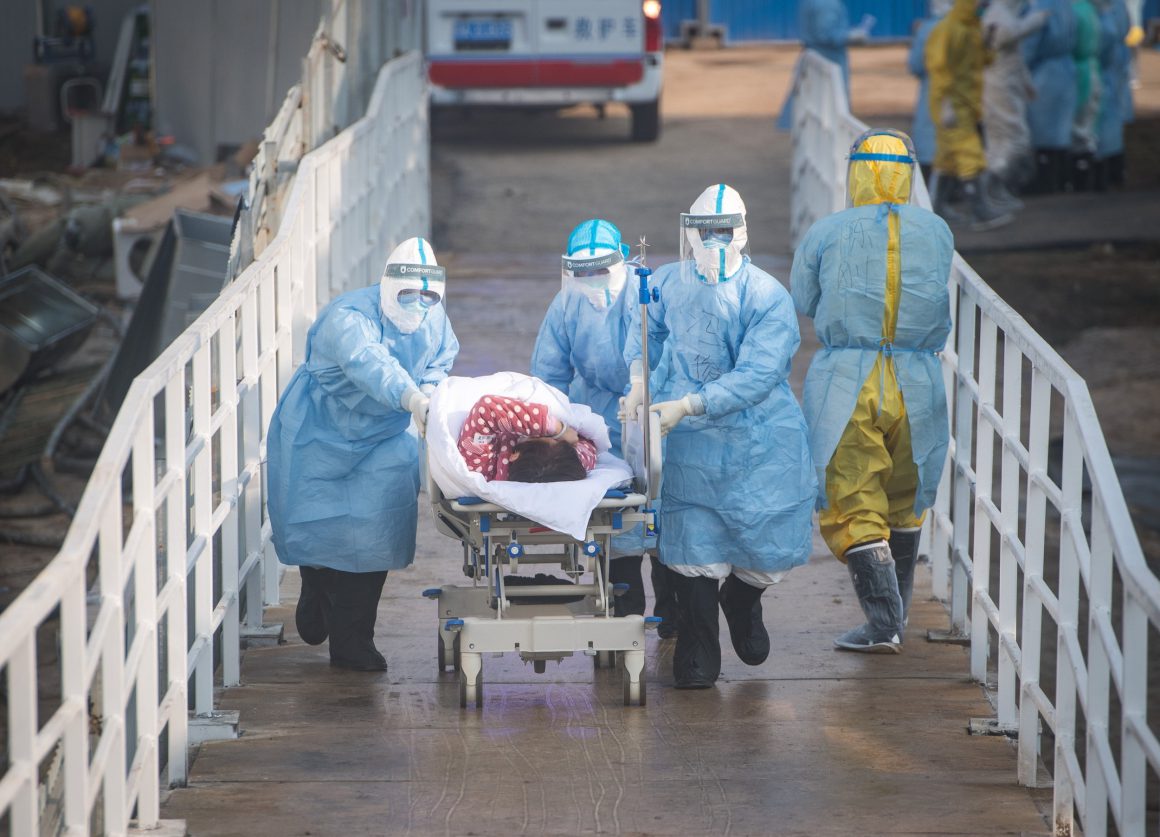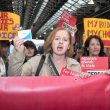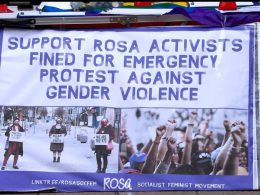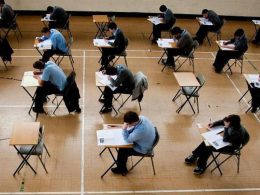“They are lying, we know they are lying. They also know that we know they are lying, and yet they are still lying.”
This online comment from a resident of Wenzhou, one of several big cities locked down under an unprecedented quarantine, underlines the explosive anger being felt across China as the novel coronavirus (2019-nCov) epidemic spreads at an alarming rate.
The current death toll is 1,018, with over 43,000 confirmed cases of infection. The death toll is rising by over 100 per day. The Chinese regime claimed the epidemic would peak by the first week in February, which now seems hopelessly unrealistic. Overseas and Hong Kong-based experts have warned the peak might not come until April or May. Many scientists express scepticism to the official Chinese reports and say the numbers infected could be ten times higher.
The virus, which attacks the respiratory system, has in the space of five weeks claimed more lives than the 2003 SARS (Severe Acute Respiratory Syndrome) epidemic claimed over a period of six months. Today’s crisis shows the so-called Communist (CCP) dictatorship learned nothing from the epidemic of 17 years ago. Worse still, the hardening of autocratic rule and extreme centralisation of power in the form of “one-man rule”, which are the two main distinguishing features of Xi Jinping’s eight-year reign, have resulted in an even clumsier, more sluggish response by the Chinese state.
With Xi at the helm, Beijing has blundered into a new crisis of historic proportions, a crisis largely of its own making. That would be bad enough if it wasn’t a repeat of what it did last year, creating a once-in-a-century crisis in Hong Kong before producing a similar outcome in Taiwan.
Coming in rapid succession, and further accentuated by an unprecedented superpower struggle with US imperialism (with the epidemic destined to become an additional battleground in this conflict), these crises have begun to sap the confidence of China’s ruling elite and its previously rock solid belief in the CCP’s authoritarian capitalist model. Xi, the ‘strongman’ who was charged with rescuing CCP rule, looks more likely to trigger its downfall. The regime’s botched handling of the epidemic is “as close to an existential crisis for Xi and the [CCP] than I think we have seen since 1989,” said Bill Bishop, a US commentator.
The short history of the novel coronavirus outbreak is one of bureaucratic paralysis and mismanagement by local officials, and cover-ups rooted in what Minxin Pei describes as the CCP’s “pathological secrecy”. This was followed by a draconian crackdown ordered from Beijing to impose its authority, having realised — too late — what it could have learned much sooner if its gigantic security apparatus had not rounded up and terrorised those who were trying to warn society of the impending danger.
Humanitarian, economic and political crisis
The result is a humanitarian, economic and political crisis all rolled into one. 60 million people — an Italy — are in locked-down cities since the dictatorship ordered the biggest quarantine in world history on 23 January, the eve of the Chinese New Year. Tens of millions more in cities all over China are confined to their homes with tight restrictions allowing only one family member per day to go out to buy necessities.
Quarantined cities like Wuhan — the epicentre of the epidemic — have come to resemble wartime conditions, with the population facing severe hardships, acute shortages of medical supplies and long queues to see a doctor in an underfunded and overwhelmed hospital system. Hu Xingdou, Professor of Economics at Beijing Institute of Technology, described the situation as “apocalyptic” and compared the quarantine conditions to those during the Great Famine of sixty years ago.
Tens of millions of workers have been idled without pay as factories and offices are shuttered. The New Year Holiday was extended by ten days in most of the country and even longer in some regions. Teachers are going unpaid as schools are ordered to stay closed until further notice.
Millions of migrant workers from inland provinces find themselves at the mercy of new quarantine rules and travel restrictions that have proliferated across the country. A video has gone viral showing a married couple stranded on a bridge that links two provinces, Guizhou and Chongqing, because the two governments have blocked travel between them.
Hubei, where Wuhan is the provincial capital, has ten million migrants living and working in other provinces. These workers face discrimination and even persecution. As Li Yuan in the New York Times reports, “As they try to contain the spread, local governments are showing that they are better at looking busy than they are at finding a solution. Many are now finding ways to track down and even expel residents from Hubei Province to keep the coronavirus from spreading.” This risks driving these workers into hiding, undermining the fight against the epidemic.
The tough measures initiated by Xi and the Politburo Standing Committee amount to a “sledgehammer” approach according to Human Rights Watch. Most of China has ground to a halt. This has produced new strains in China’s state system, with different regions imposing their own quarantine measures and squabbling rather than coordinating over emergency resources.
Dali, a city in Yunnan province, intercepted a shipment of masks headed for Chongqing triggering a dispute between the two governments. State media also reported that medical products en route from South Korea to the city of Shenyang were impounded by customs officers in Qingdao. The Qingdao authorities claimed this was retaliation for Shenyang officials having seized a consignment of supplies destined for Qingdao. Such incidents have generated disgust and anger on social media.
“Manmade disaster”
“This is truly a manmade disaster,” commented one post on social media which sums up the situation well. Despite the state censors working manically to erase them, such anti-government views have now become “a flood-level event” as described by a leaked internal government report.
The anti-government mood reached a new level with the death on 6 February of the “rumourmonger”, Li Wenliang, a doctor at the Wuhan Central Hospital. Li was forced by police on 3 January to sign a letter saying he spread “untrue speech” by warning colleagues of a new SARS-like virus. His example was used as a deterrent to make other medical staff in Wuhan keep quiet.
When news broke that the reprimanded Wuhan “rumourmongers” — Li and his colleagues — were all medical professionals who had tried to sound the alarm, anger exploded on social media. The CCP was forced to treat Li, who had by this time been infected with the virus, gently and permit him to do media interviews. The Supreme People’s Court even issued a statement stating that Li should not have been punished.
This was an attempt by the central government to contain and defuse mass discontent, direct it downwards at Wuhan officials, in preparation for even more censorship and persecution of “rumourmongers” in the future. Any tactical concessions by Xi’s regime, as shown in Hong Kong last year, do not signal a change of course but merely attempts to buy time for the continuation of hardline authoritarian rule.
In a final interview given to Caixin Global, Li’s very moderate words have come back from the grave to haunt Xi’s regime: “I think there should be more than one voice in a healthy society, and I don’t approve of using public power for excessive interference.”
Even Li’s death, first announced on 6 February, then “reversed” by state-controlled media, and re-announced on 7 February, was the focus of yet another not-so-clever cover up. Presumably, the CCP’s vast propaganda and censorship machinery needed more time to prepare its spin on the doctor’s death. The news unleashed an unprecedented online surge of anti-government anger. Millions shared posts about Li Wenliang and the hashtags “I want freedom of speech” and “We demand freedom of speech”– were viewed by tens of millions before being censored.
The hit to China’s and the global economy from these events is likely to far exceed the effects of the SARS epidemic. In 2003, China accounted for just four percent of the world’s GDP whereas today it is 16 percent. It is not at all far fetched, especially given the fragile state of the global economy, to envisage the epidemic becoming the tipping point into a global recession. This is because of China’s decisive role, accounting for over 30 percent of global GDP growth last year.
The car industry, already in recession worldwide, faces massive disruption as shown by the shutdown of all Hyundai’s car plants in South Korea due to lack of parts from Chinese suppliers. European carmakers face a similar squeeze if the problems in China drag on. It is unclear when China’s car plants and other major industries will resume normal production after the extended shutdown caused by the epidemic.
But the problems go much deeper. A more prolonged epidemic could be the needle that bursts the huge bubble in China’s housing market. That it turn risks sparking a banking sector collapse. Wuhan, China’s fifth largest city, is a prime example of an unsustainable bubble. The city’s house prices have quadrupled in the past two years.
“People with money are scared to death and don’t dare run around outside,” a Beijing-based real estate agent told the Financial Times. “No one is going to work. The real estate developments are all locked up . . . the impact will certainly be big.”
Wuhan: Timeline of a disaster
In the first critical weeks of this crisis the government in Wuhan did the absolute opposite of what it should have done. They arrested and silenced whistle-blowers including medical professionals like Li Wenliang who tried to warn about a potential epidemic. They did not even inform hospital staff of the dangers, another source of public anger now that large numbers of medical personnel have been infected. This includes 40 staff members at a single Wuhan hospital.
Five million people are estimated to have left Wuhan and travelled to other parts of China in the period 1–20 January, without knowing they could be carrying the virus or being warned to take elementary precautions such as wearing masks, washing hands regularly, and avoiding public gatherings.
Wuhan officials went ahead with a banquet for 40,000 families in the Baibuting district on 18 January — just days before the city was locked down completely and all outward travel banned. Today, dozens of buildings in Baibuting with its 130,000 inhabitants are plastered with official red notices reading, “fever buildings”. Caixin Global quoted local residents complaining they have still not been advised by government officials over what precautions to take even after their homes were designated “fever buildings”.
The World Health Organisation (WHO), a UN agency, was informed by officials at China’s national health ministry on 31 December of an outbreak of “pneumonia of unknown cause” in Wuhan. A week later the virus was given the name 2019-nCov. This timeline implicates Beijing, which is hiding behind the mistakes of the Wuhan government, for failing to act more quickly. Despite a stack of evidence to the contrary, the WHO is praising the Chinese dictatorship’s handling of the outbreak, even hailing “China’s system” and Xi’s “great leadership capability”. The fawning support of a few bureaucrats in Geneva is small consolation to the CCP as it encounters ever greater hostility at home.
Revolutionary tremors
Beijing is now in an acute damage limitation phase, attempting to protect the personage of “the Emperor” Xi, and deflect all blame onto the Wuhan government and police. The Politburo Standing Committee — the CCP’s inner circle — recognised the current situation as “a major test of China’s system and capacity for governance”.
The CCP is deploying its full armoury of ‘stability maintenance’ measures with a massive propaganda and PR drive, erecting hospitals at record speed and proclaiming a “people’s war” against the epidemic. Despite two new hospitals built in Wuhan, which its government says offer an additional 13,000 beds, this is still insufficient — there are independent estimates of up to 190,000 infected people in Wuhan.
Beijing recently announced US$12 billion in emergency funding to fight the epidemic. But in the same week it pumped US$174 billion into the banking sector and stock market to prevent a market meltdown. The gap between these two sums shows the real class allegiances of China’s rulers.
Where can this lead? In the Financial Times Jamil Anderlini argues that “if the virus cannot be contained quickly, this could turn out to be China’s Chernobyl moment, when the lies and absurdities of autocracy are laid bare for all to see.”
The same point has been made by many netizens in China, drawing comparisons with the 1986 nuclear disaster which was an important event undermining the basis of the Stalinist regime in the USSR. Anderlini also draws a parallel with Tunisia in 2010, comparing Li Wenliang with Mohamed Bouazizi, the fruit vendor who’s self immolation acted as the trigger for the Tunisian and wider Arab revolution.
It is clear the Chinese dictatorship has entered its deepest crisis since the late 1980s. The March ‘twin sessions’ (NPC and CPPCC meetings) may now be cancelled on grounds of the epidemic. If this happens the real reason is more likely to be to prevent open expressions of dissent surfacing at this normally highly choreographed event.
The power struggle inside the CCP and ruling elite will almost certainly reignite, fuelled by growing divisions over Xi’s stewardship, but also ultimately reflecting the new moods stirring in society’s base. If the epidemic is not contained in the short-term and inflicts massive economic damage, this can unleash a new level of crisis with potentially revolutionary implications.
The task of Marxists, of the supporters of the ISA in China, is to help the most advanced sections of the working class and the youth to prepare politically. China’s humanitarian, economic and political crisis cries out for the building of a socialist and genuinely democratic workers’ alternative to the CCP’s authoritarian capitalism.












